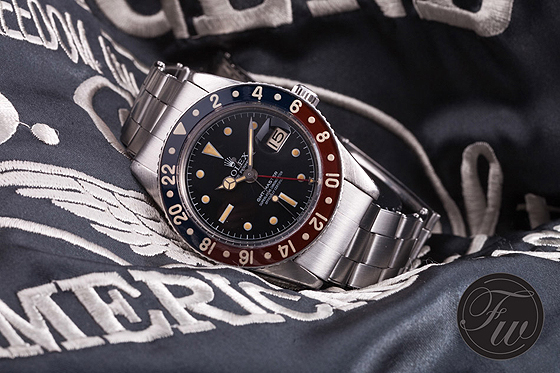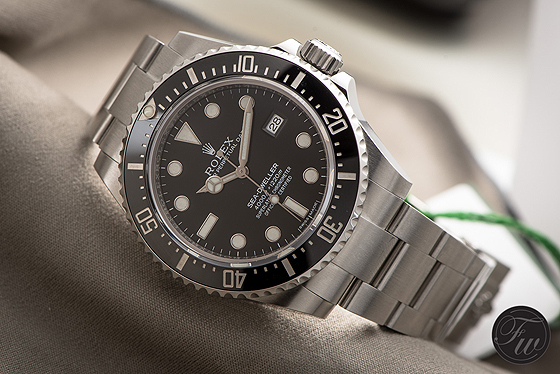GREAT ARTICAL FROM
http://www.watchtime.com/
BY ROBERT-JAN BROER
Advice for Collectors: Buying New vs. Vintage Rolex Watches
Just to warn everyone up front, this article concerns my personal opinions on buying and collecting Rolex watches. Whether one likes it or not, one cannot deny that Rolex still gets more attention from watch consumers than any other watch brand. I respect Rolex for what it is able to accomplish (producing high-quality watches in large numbers for reasonable prices) and I own and have owned my share of Rolex watches, both vintage and new.
My opinion on this subject changes once in a while, I must admit. Once, I even wrote an article on why I don’t collect vintage Rolex watches, yet now I seem to be “stuck” with only vintage Rolex watches in my modest collection. However, I remain strongly opinionated about vintage Rolex. In this article I will tell you exactly why, and why it might be safer (and perhaps just as much fun) to buy a brand-new model.
Let me start by telling you why I love vintage Rolex watches. Like most other vintage watches (from other brands), a Rolex sports watch from the 1960s or ’70s has an aura of adventure; the wear on the case and bracelet show that the watches had something of a rough life; the things that the watch witnessed might have been awesome. The fun with vintage Rolex watches is that because there are so many of them around, you can usually find the exact “configuration” that suits your personal taste. For example, I don’t like the ones with the old tritium markers that have turned a mustard yellow color; I prefer them slightly off-white. I also don’t like spider-web dials (cracked paint) and prefer them to be all-matte with big, round hour markers. And I would rather have a watch that had decent servicing throughout the decades than a watch that still has its original crown, seals and crystal. But I know that there are dozens of people who prefer just the opposite.
I’ve learned that a lot about buying and collecting vintage Rolex has to do with aesthetics. There is little interest in the mechanical movement; people generally trust it to be good. (It is a Rolex, for crying out loud.) Many collectors tend to be more interested in a nice-looking dial, or matching pair of hands, than to making sure the movement is all nice and fresh. Nothing wrong with that, of course, and these movements are fairly easy to service, but I always make sure that the watch is in perfect technical working order as well.


Now, the other side of the story is that there is a lot of fraud going on in the vintage Rolex scene. As with all transactions in which serious money is involved — whether it be classic cars, paintings, real estate, even adopting babies — there are always those who want to cheat and scam other people who wish to own a certain commodity (in this case, a watch). There are dealers who claim to have million-dollar businesses selling vintage Rolexes, who claim to be able to supply whatever model you need or whichever is in demand at that moment. Be very careful of those types of dealers. I’d advise you to seek out a guy who trades vintage Rolexes as a hobby (or a passion), rather than to enter a store that has dozens of vintage Rolex watches that are labeled “exclusive” and carry crazy price tags.
“Exclusivity” is another important issue. Most Rolexes are not exclusive, in terms of numbers, to start with, even vintage Rolexes. Rolex has always been a watch manufacturer with a high production capacity. Collectors have made them “exclusive” because of their needs for certain models with specific signs of aging or specific wording on the dial. In truth, if you have unlimited resources, you can buy just about any vintage Rolex there is (with exceptions, of course, such as prototypes or models that had a specific professional purpose). You want a Paul Newman Daytona? No problem, as long as you can show the money. The only thing that makes a vintage Rolex “exclusive” is its price tag, to be honest. There are watches from other brands out there that are much harder to get, and perhaps also more technically interesting, but let’s face it. The demand for vintage Rolex watches is incomparable.
So, in the end, if you want to buy a vintage Rolex timepiece, make sure you know your budget and know exactly what you want. If you – like me – don’t care too much about the position of the wording on the dial, how yellow the patina will be, or how faded the bezel should be, you are fairly safe. In any case, make sure you “buy the seller,” which means that you should be able to trust the seller in order to make the purchase. It is impossible to know everything about vintage Rolex watches, but you should feel comfortable with the watch that the seller is offering you. If he says it is fine and you did a plausibility check, you should be able to take his word for it. Some sellers offer your cash back if anything appears to be incorrect after the purchase. Make sure to do a check on the good guys out there by using the online vintage Rolex communities. However, always try to think logically when you are looking at a vintage Rolex for sale. Do not lose your head over it. If it doesn’t feel good, then don’t pull the trigger.
Let’s now shift the focus to the other side of the spectrum, discussing the merits and pitfalls of new and modern Rolexes.
You might already know that buying vintage Rolex watches can be — how can I put this mildly — scary shit. If you “just” want a good watch and don’t want to get dragged into the quest for that perfect vintage Rolex, you might want to consider buying a new Rolex instead.
A lot of people — mainly watch enthusiasts — will tell you that buying a new Rolex is “boring” and that you can purchase other interesting watches for the same price or less. This may be true, but please bear in mind what’s important to you. If you want a watch that will last a lifetime (or two) and that does not depreciate too much (usually the opposite will be true, if you are patient enough), then a modern Rolex might be a good choice.
Although the Rolex company is as tightly closed as its own Oyster cases when it comes to providing information, the general assumption is that it produces close to a million watches per year. The lucky few who have been inside the Rolex production facilities have reported on an impressive number of automated processes there that are unlikely to make mistakes that humans would make. All watches are still assembled by hand, of course. And the high quality that Rolex is able to maintain on such a high production number of watches is truly incredible.
It is no secret that a lot of people did complain about the lack of innovation at Rolex up until a few years ago. At the time, Rolex still used the clasp that looked as if it was made from soda-can material, the relatively small (40 mm) case diameters for its sports watches and the same movements it had been using for decades. In the last few years, however, Rolex has introduced more innovations and changes than it did in the previous four decades. Rolex upgraded its bracelets by adding new clasps that have a super-easy system for (micro)adjustment, started using ceramics for its bezels, tweaked its movements with the new Parachrom hairspring, and even made its watches appear bigger. “Appeared?” Yes. For instance, the latest Sea-Dweller 116600 and GMT-Master II 116719BLRO with Pepsi bezel are still 40 mm in diameter, but appear larger because of the dimensions of their lugs.


Another point some watch enthusiasts like to raise is that Rolex watches are outrageously expensive. I beg to differ, actually. Rolex watches were never cheap to start with, so everything is relative, but there are a few things you need to consider.
A new Rolex Submariner has a price tag of just over $8,500. On the pre-owned market you can find this watch for around $7,000, in good condition, approximately 1-2 years old. I will leave the bargaining at an official Rolex retailer up to you. My point is that the depreciation is only small compared to – basically – that of every other brand in this price category. You can have an awesome $8,000 watch from any other brand, even with some interesting complications in there, but will it keep its value? Since you are visiting this website, I’d assume you also know how to find your way to the online watch markets that carry all sorts of watches. Take a look at what is left of the list price on many of these other watches after a couple of years. Additionally, it’s worth mentioning that Rolex has an excellent service department. A total overhaul of your Rolex watch is expensive, but when you get it back it will look as it did the day you unwrapped it for the first time.


My personal experience with Rolex’s Geneva service center is that I actually had to double-check to see if they didn’t replace the case of my Sea-Dweller 16600 when I got it back from an overhaul (they didn’t). I could not believe my eyes. It took them about six weeks, which is quite stunning compared to other watch companies. I have watches from other brands whose servicing took much longer, sometimes up to six months even for something as relatively simple as adjusting the movement. It’s been my experience that many watch manufacturers forget about you as soon as you buy something from them and would rather spend their money on celebrity “ambassadors” or expensive marketing campaigns, but it seems that Rolex actually cares a lot about the after-sales service.
Servicing vintage watches, of course, is a totally different issue. Parts might not be available anymore, new spare parts can mess up the value of your highly sought-after vintage watch, price quotes can be as high as those for a modern watch, and so on.
Whatever modern Rolex you will choose, it will be a quality watch. The chance that something will be wrong with it is very small, and the possible resale value (though there are no guarantees) is another incentive. My pick would be between the new Rolex Sea-Dweller 16600 mentioned earlier or the Rolex GMT-Master II 116710BLNR. What would be your pick? Please share with us.